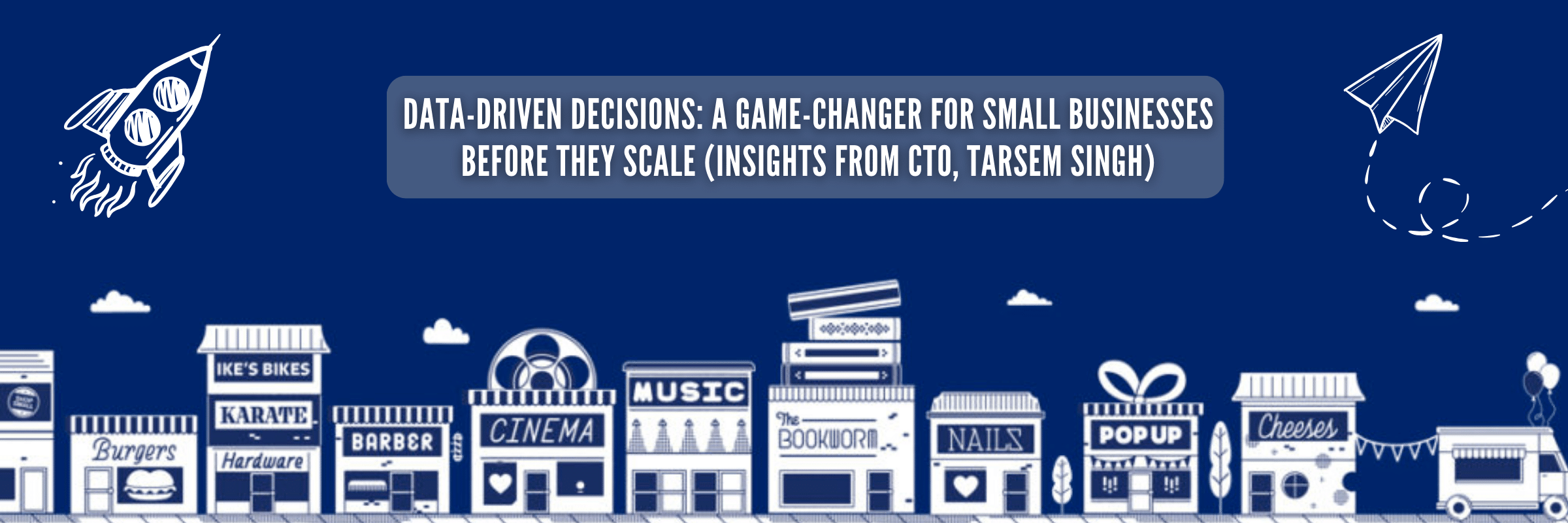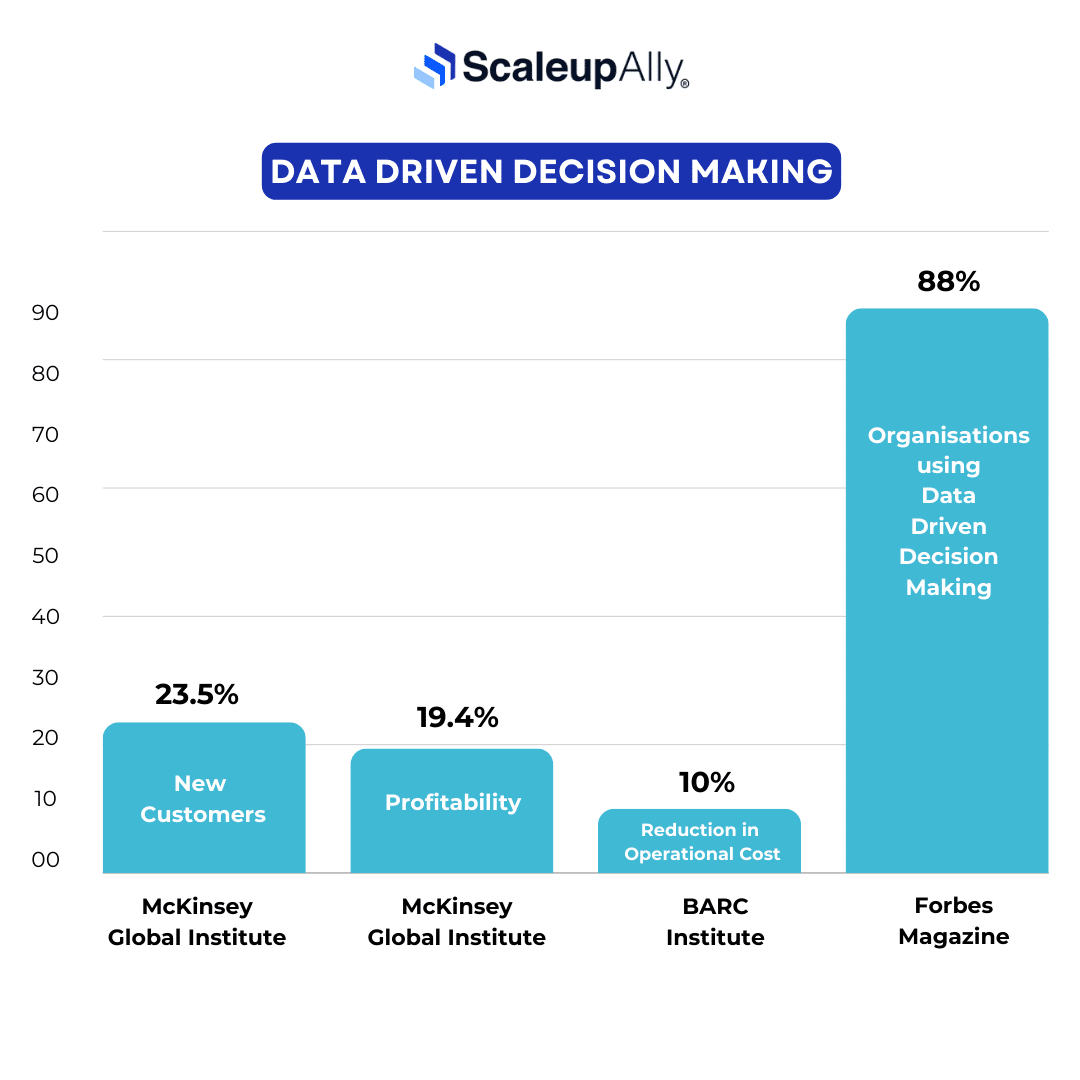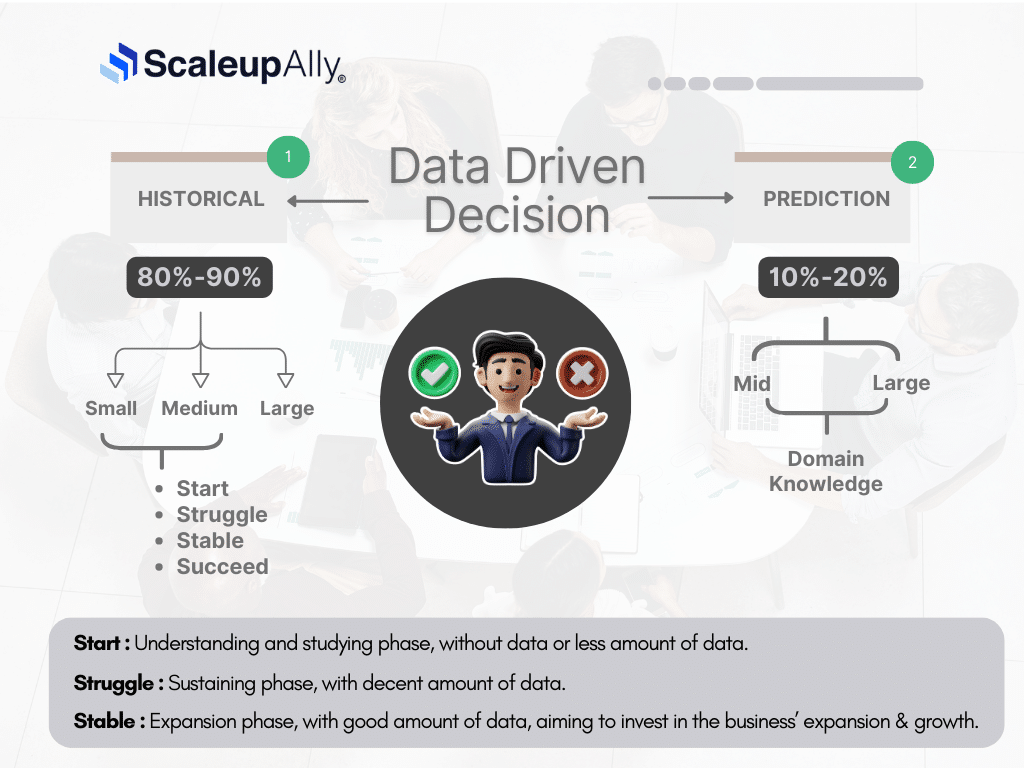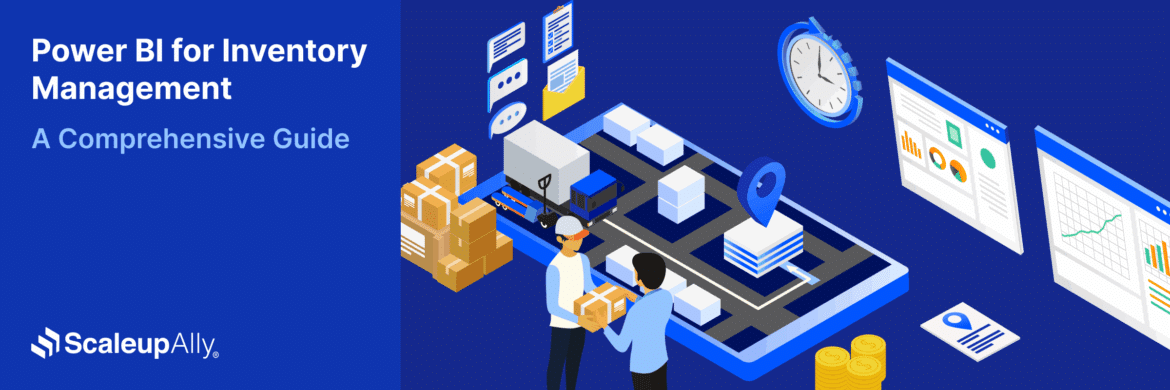
Data-Driven Decisions: A Game-Changer for Small Businesses Before They Scale (Insights from CTO, Tarsem Singh)
ScaleupAlly Team | September 8, 2024 , 12 min read
Table Of Content
“Data-driven decisions are the future, and the future is already here,” quoted by Masayoshi Son, a Japanese billionaire, technology entrepreneur, investor and philanthropist. The usual rule of thumb is, to go with one’s intuition.
There is enough literature and studies on how intuitive instincts have shaped the world. The hunch may guide you, however according to a survey done by PwC, the chances of hitting the right chord, i.e., a performative decision is three times more effective with a data driven roadmap.
It is now implicit, how the data is the game changer for the businesses. “The catch is to give shape to these scattered data points, to more directional destinations, where all of the growth leads its way right through it.
From intuitive to rationalized decision making, business life comes full circle,” endorses Tarsem Singh.
Let’s see what the Data says, shall we name it Mr.Data?
- There are 23% of chances to acquire new customers/clients with DDDM (Data Driven Decision Making), and six times the probability of retaining the existing customers/clients, and 19% more profitable, according to Mckinsey Global Institute.
- BARC studies suggest DDDM (Data Driven Decision Making) accommodated by organizations saw a 10% reduction in their operational costing.
- Forbes Magazine says, 88% of the organizations have been using DDDM (Data Driven Decision Making) for improved understanding of their customer behaviour, to introduce more features and products.

Key Takeaways
- Data-driven decision making (DDDM) delivers more accurate decisions, reducing reliance on intuition and minimizing costly errors.
- Companies employing DDDM see higher customer acquisition and retention rates, driving increased profitability and growth.
- It enhances operational efficiency by identifying bottlenecks, optimizing processes, and reducing unnecessary costs across business functions.
- DDDM empowers personalized customer experiences and targeted marketing, boosting engagement and loyalty in competitive markets.
- Small businesses can leverage DDDM to manage risks effectively, discover new opportunities, and make smarter strategic decisions.
What is DDDM aka Data-Driven Decision Making?
- What is DDDM aka Data-Driven Decision Making?
- When Should Small Businesses Make an attempt at Data-Driven Decision Making?
- Why Should Small Business Owners Adopt Data Driven Decision Making?
- Tools or Resources would you suggest for a Small Business diving into data driven business decisions?
- What are the Essential Components of a Data Infrastructure that a Small Business should consider investing in?
- How should Small Businesses measure the success of their Data Driven Initiatives?
- Example of how Data Driven Decision Making has made a difference for a small business?
- Key Metrics to Track Before Scaling
- Final Thoughts
At its very core, DDDM (Data Driven Decision Making) is about using relevant data to take charge of the business choices rather than relying on intuition alone. The entire chain involves collecting, analyzing, and interpreting data to make room for informed decisions that are grounded in facts rather than assumptions. It is an empirical evidence to shape strategic plans, often made easier and more accessible through data analytics services tailored for business needs.
Tarsem recollects, he read in a 2019 Score report, for about 51% of small businesses place firm faith in the significance of big data. What’s more, companies that do take advantage of data analytics tools enjoy 15% more in sales than those that don’t.
Although, as hard as it is to get hold of the tech lead for a discussion, we jumped at the first opportunity we got. In an attempt to pick his brains, we exchanged views on DDDM and how irrefutably it is a game changer for small businesses before they scale, with the forward thinking CTO of ScaleupAlly, Tarsem Singh. Let the stat out of the bag!
How do you define DDDM within the context of Small Businesses?

When Should Small Businesses Make an attempt at Data-Driven Decision Making?
DDDM is not very technical, but mostly creative. It may look technical as it requires coding, some statistics and math to do the calculation, Tarsem affirms, “It is creativity at work with Data.” So when should a business think about it?
- Growth Hits a Snag: If your business was cruising along smoothly but recently hit a growth plateau, it might be time for some data driven business decisions.
- Operations Feel Clunky: Inefficiencies or rising costs? Let’s say you’re running a logistics company and are noticing issues with delayed deliveries. Now your customers are growing impatient! DDDM comes handy by looking at production data, analyzing route data, spot choke points and pinpointing exactly where things are going wrong. This insight lets you even out any operational bottlenecks and better customer satisfaction with timely deliveries.
- Eyeing New Market Opportunities: If exploring new markets or products is in the pipelines, DDDM spots the right opportunities. For instance, if you run a fitness apparel brand and want to explore new product lines, analyzing market trends, better insights on emerging trends, competitor offerings and customer preferences can give you hints to areas with high demand.
- Want to Optimize Marketing Efforts: Running several marketing campaigns, spending hefty amounts, without seeing the light of the day. Waste! By analyzing campaign data, customer acquisition costs, and conversion rates, you can figure out which strategies are hitting the mark for best ROI and adjust your marketing budget smartly.
- Customer Service is not Servicing: In case the customer service team is getting a lot of angry complaints and you’re not sure why, sorted data gets to the root of the problem. For example, analyzing call center data and complaint trends can reveal common issues and help you make targeted improvements.
Why Should Small Business Owners Adopt Data Driven Decision Making?
For small business owners, the stakes are high, and every decision, even minor ones can have the butterfly effect which might affect the business in the hindsight, but invisible in the immediate scheme of things. The CTO of ScaleupAlly highlights a few key reasons why DDDM is a must for small businesses:
- Increased Efficiency and Understanding: Data can reveal inefficiencies in operations, which could break the camel’s back. For instance, analyzing sales data might highlight inventory management issues or identify the most profitable products with untapped potential. DDDM lets you ideate better with sales data, consumer feedback and market trends. One may hit the sweet spot with a product with moderate sales, but with appropriate adjustments in pricing, smart marketing, or adding new features, may fetch a higher ROI. From underperforming to outstanding sales, DDDM is that magic wand.
- Smart Decision Making: “Small businesses often operate with limited margins and need to be agile. Data helps them make smarter decisions quickly,” explains the CTO. Let us take an example of a retail store. Make observations on what products aren’t making the cut and why? Using DDDM, study purchasing patterns, customer demographics, and seasonal trends. Now you are armed, finding gaps using DDDM, allows you to adjust your inventory and marketing strategy. This is smart decision making in action.
- Personalized Customer Experience: Once the data is cleaned, and arranged, marketing and services to meet the needs of their customers becomes a cake walk. “This gains customer loyalty,” the Tarsem notes. An online clothing store, for example, can analyze in great detail, customer data, browsing history, past purchases, preferences. This study of customer behaviour lets you position yourself better.
- Risk Management: Saving sudden stock loss, due to unanticipated events, where DDDM can easily mitigate the issue. Case in point, Warehouse stock management. The Suez canal crisis happened, we all know the supply chain was acutely disrupted. And similarly, sudden unexpected stock shortages may occur, here only DDDM can rescue! Historical data on inventory levels, supplier reliability, potential market risks, all this can help one develop a contingency plan. Continuity, and minimal losses keep the boat floating.
- Competitive Advantage: In a competitive market, having an edge can make all the difference. For instance, small businesses can study competitors, their strategies, customer preferences, identify gaps in the market, and create competitive offerings. “This way Small businesses can position themselves better in the market using DDDM,” says Tarsem.
- Better Financial Management: Since the inventory management gets sorted, risk has been mitigated, time has also been freed for core decisions, all of these prevent fund leakages, and DDDM predictions allow businesses to save on extra costs.
- Stability and Growth: DDDM is an ally of the business ecosystem, once it gets assimilated with the business’s skeleton, and we know nothing provides the stability like backbone. For example, Netflix uses DDDM to personalize content recommendations by analyzing user viewing habits. This data-driven approach increases customer retention and satisfaction, while also guiding content investment decisions. As a result, Netflix achieves stability through consistent engagement and growth by expanding its library with highly demanded content.
Tools or Resources would you suggest for a Small Business diving into data driven business decisions?
Tarsem suggests, “for basic analytics, platforms like Google Analytics or HubSpot can be very useful. If you’re looking for more in-depth insights, consider CRM systems like Salesforce or data visualization tools like Power BI, Tableau. The key is to choose tools that are user-friendly and fit your specific needs.”
What are the Essential Components of a Data Infrastructure that a Small Business should consider investing in?
Tarsem emphasizes, to invest in tools which are secure, for others with poor security may compromise your data and kill your business from the ongoing competition. Many concerns like sensitive data security, data leakages may have a snowball effect, which could prove disastrous.
How should Small Businesses measure the success of their Data Driven Initiatives?
“Simple! Check your Profits or Traction.” smiles Tarsem.
Example of how Data Driven Decision Making has made a difference for a small business?
“Absolutely. One of our (ScaleupAlly) clients, Soha Living, is a local retail store based in Hawaii. They were struggling with inventory management. By thoroughly analyzing their sales data, we identified patterns in customer purchases and seasonal trends.
With these insights, they were able to adjust their inventory levels, reduce overstock, and ensure they had the right products on hand at the right times. This not only improved their sales but also reduced waste and increased profitability.” Tarsem shared.
Key Metrics to Track Before Scaling
Keeping an eye on these benchmarks show a detailed view of the business’s performance and where it’s headed. Tracking these metrics helps in identifying opportunities and adapting to changing variables to keep the growth trajectory on track.
- Revenue Growth: This metric highlights how much money the business is bringing in compared to previous periods, indicating whether the business is growing or shrinking, or stuck in stagnancy.
- Net Profit Margin: This calls attention to what percentage of our revenue is left after all business expenses are paid. A higher net profit margin means a more profitable business.
- Cash Conversion Cycle (CCC): For product-based businesses, this gives an idea of how long it takes for money to move through the business, considering inventory selling time, receivables collection, and bill payment.
- Customer Acquisition Cost (CAC): Measures how much it costs to bring in new customers and how smartly we’re acquiring them.
- Customer Lifetime Value (CLV): The total value of a customer throughout our relationship, factoring in variables like repeat purchase rate, CAC, and average order value, is what CLV tells.
- Customer Retention Rate: Important one! Acquiring new customers costs more than retaining existing ones. It tells the percentage of customers/clients who return to do business after making an initial purchase.
- Customer Churn Rate: Gives the percentage of customers who leave our business over a given period, indicating how sticky our customer base is.
- Average Order Processing Time: Evaluates the efficiency of the order processing system.
- Order Accuracy: Reflects how well the business is fulfilling customer/clients orders.
- Employee Efficiency: Measures the team’s productivity levels.
- Website Traffic: Shows the number of visitors to the website, giving insight into how well the online presence is performing.
“Data isn’t just numbers and charts; it’s a storehouse of insights waiting to be uncovered. For small businesses, data helps you understand your market, track performance, and make informed decisions,” nods Tarsem.
For the readers, a few reading suggestions by Tarsem, which he personally likes to read or watch for updates on the subject: Bernard Marr, Data Science Central, Business Insights from Harvard Business School Online.
Final Thoughts
Tarsem casts our mind to the Grofers Story. Once was a small business, with a humble beginning in 2013, it started with on demand pick-ups and drop services from peripheral areas, for pharmacy, grocery, restaurants etc. Now, it has expanded and soon to be an Unicorn company.
The subtle nudge theory in action using DDDM is how the model works. They study their customer’s activity data, understand demand with much accuracy, saving bucks. They optimise routes of delivery, stock management with better predictions as to when and what products their customer may order.
They study time and time’s relationship with customers and their business system. And we all know, time is money and money is time. Don’t we?
Citations:
- PwC
Market Stats 1
Market Stats 2
Score Report
Related Blogs

Data Warehouse Cost Breakdown: Factors, Pricing Models & Platform Comparison
Discover how much a data warehouse costs in 2025. Explore pricing models, key factors, and platform comparisons to plan your data budget effectively.
Tarsem Singh
Nov 6 ,
14 min read

How Much Do Integrations Cost? [Pricing Breakdown & Key Insights]
Learn how much integrations cost, key factors influencing pricing, hidden expenses to avoid, and effective ways to reduce integration costs.
Tarsem Singh
Nov 6 ,
9 min read

Power BI for Inventory Management: A Comprehensive Guide
Explore the hidden power of Power BI for inventory management and how it provides businesses with powerful analytics and visualization capabilities.
Tarsem Singh
Oct 8 ,
19 min read


